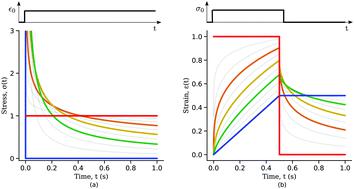当前位置:
X-MOL 学术
›
Soft Matter
›
论文详情
Our official English website, www.x-mol.net, welcomes your
feedback! (Note: you will need to create a separate account there.)
Fractional viscoelastic models for power-law materials.
Soft Matter ( IF 2.9 ) Pub Date : 2020-06-08 , DOI: 10.1039/d0sm00354a A Bonfanti 1 , J L Kaplan 1 , G Charras 2 , A Kabla 1
Soft Matter ( IF 2.9 ) Pub Date : 2020-06-08 , DOI: 10.1039/d0sm00354a A Bonfanti 1 , J L Kaplan 1 , G Charras 2 , A Kabla 1
Affiliation

|
Soft materials often exhibit a distinctive power-law viscoelastic response arising from broad distribution of time-scales present in their complex internal structure. A promising tool to accurately describe the rheological behaviour of soft materials is fractional calculus. However, its use in the scientific community remains limited due to the unusual notation and non-trivial properties of fractional operators. This review aims to provide a clear and accessible description of fractional viscoelastic models for a broad audience and to demonstrate the ability of these models to deliver a unified approach for the characterisation of power-law materials. The use of a consistent framework for the analysis of rheological data would help classify the empirical behaviours of soft and biological materials, and better understand their response.
中文翻译:

幂律材料的分数粘弹性模型。
软材料通常表现出独特的幂律粘弹性响应,这是由于其复杂内部结构中存在的广泛时间尺度分布而引起的。精确描述软材料流变行为的一种很有前途的工具是分数阶微积分。然而,由于分数运算符的不寻常符号和非平凡属性,它在科学界的使用仍然受到限制。本综述旨在为广大受众提供清晰易懂的分数粘弹性模型描述,并展示这些模型为表征幂律材料提供统一方法的能力。使用一致的流变数据分析框架将有助于对软材料和生物材料的经验行为进行分类,并更好地了解它们的反应。
更新日期:2020-07-08
中文翻译:

幂律材料的分数粘弹性模型。
软材料通常表现出独特的幂律粘弹性响应,这是由于其复杂内部结构中存在的广泛时间尺度分布而引起的。精确描述软材料流变行为的一种很有前途的工具是分数阶微积分。然而,由于分数运算符的不寻常符号和非平凡属性,它在科学界的使用仍然受到限制。本综述旨在为广大受众提供清晰易懂的分数粘弹性模型描述,并展示这些模型为表征幂律材料提供统一方法的能力。使用一致的流变数据分析框架将有助于对软材料和生物材料的经验行为进行分类,并更好地了解它们的反应。











































 京公网安备 11010802027423号
京公网安备 11010802027423号